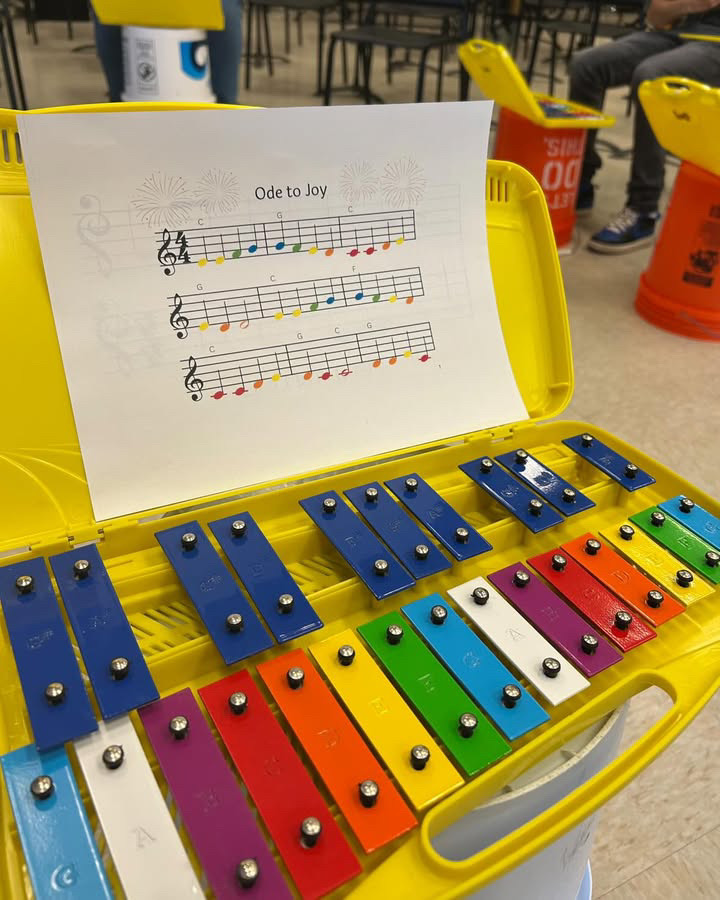From foster to family: Whitman boys embrace their role as foster siblings
November 29, 2022
After school, most students go home, grab a snack and unzip their backpacks to dive into a night full of homework. However, Bennett Browning (‘22) and sophomore Beckett Browning have something else on their minds when they walk through the front door: caring for their foster siblings.
Diaper changes, bottle refills and toddler tantrums often come before completing assignments and studying for tests.
Since February 2020, the Browning family has fostered eight children. While two children were short-term placements who only resided in the Browning home for a couple of days, the other five stayed with them for months at a time. Most recently, the family fostered their first girl — a 14-month-old baby — who was the Brownings’ oldest long-term placement. After five months in their care, she moved in with a new family looking to adopt to begin forming a bond with them.
Becoming a certified resource family requires an extensive process consisting of interviews, fingerprints, stacks of paperwork and 10 weeks of training. During their training, Nancy and Cassie Browning, Bennett and Beckett’s parents, performed practice scenarios of difficulties they might experience while fostering. In November 2019, after completing the required course, the foster system assigned the Browning family a social worker to inform them of possible placements. Having both dreamt of fostering children since they were young, Cassie and Nancy were excited to receive their first placement, Cassie said.
“When I grew up, the adults in my life were very important and helped me find my path,” Cassie said. “I wanted to give that experience back to the children.”
In 2019, before beginning the fostering process, the Brownings decided to only accept placements ranging from infants to 14-year-olds because Beckett wasn’t keen on fostering older teens. However, now the Browning’s long-term placements consist of exclusively infants and younger children as a result of the abundance of toddlers and infants in the foster care system who need a loving home. Many families aren’t willing to take in children under the age of two due to the fact that they’re difficult to manage and care for due to the fact that childcare centers only start at two years old, Nancy said.
While some families foster with the intention of adoption, this was never the Brownings’ plan. The same year they settled their preferred age range, they also collectively agreed to solely foster children instead of adopting them. Although their social worker offered the family a chance to adopt one of their long-term foster children later on in their fostering career, they ultimately decided to stick to their original plan even though it was difficult for all of them, Cassie said.
In February 2020, the Brownings received their first foster placement, an infant weighing only four and a half pounds — three and a half pounds under the average weight of a baby that age. Shortly after receiving their first infant, many other resource families closed their homes to placements in fear of contracting COVID-19. However, the Brownings chose to continue providing foster support because they knew many children would still need a temporary home.
The infant resided with the Brownings for around one month before he was moved to a new location prior to the March COVID-19 surge.
The family’s second long-term foster was a premature baby that stayed with them for nine months. When the Browning’s social worker reached out asking if they would take in another child during the heart of the pandemic, the Brownings felt conflicted. Taking on another foster placement would be difficult because of the many extra precautions they would have to take to care for a newborn. Despite this predicament, when they heard about the child’s heart condition, the family decided that they would make space for him in their home.
“We thought both for him and the fact that we were a conservative family as far as really wearing masks and trying to be diligent, it would be a good match,” Cassie said.
Every time a child is placed in the Browning’s care, Bennett and Beckett make it a priority to ensure the child feels comfortable in their home. The brothers play games, read books and teach their new siblings how to communicate. The entire family enjoys the extra company the foster children provide, Bennett said.
“It’s just like having another brother,” Bennett said. “There’s something positive in every aspect of it.”
After The Department of Health and Human Services relocates a child from the Browning home to their new permanent residence, the family eagerly awaits their next placement. Although the process can take any amount of time, ranging from a few days to a year or more, the Brownings typically wait a period of four to five months before receiving their next placement.
When the Brownings’ social worker places a child in their home, they inform the family of a court hearing date which determines whether the child will stay with the family until their guardian is ready to take care of them or if they’ll be placed into someone else’s care after their time with the Brownings.
Cassie and Nancy have the option to go on parental leave once their social worker calls them in need of a home for a child. They have access to up to 12 weeks of paid leave per year providing flexibility to bond with their new family member, as well as time to figure out a childcare plan and ensure that the child is adjusting to their new home.
“It’s really nice to have those days to settle down with them, bond with them and let them know everything’s gonna be okay,” Nancy said.
To properly welcome a new child into their family, Cassie and Nancy ensure that their house is baby-proofed and that the child has activities or daycare to keep them entertained while they are at work. The Browning’s neighbors also step in to provide the family with childcare resources in case of a hurried placement.
“Many of our friends and neighbors will drop off diapers, formula and all of the things that you need in the first couple of weeks which is really a blessing,” Cassie said.
Considering that they receive foster infants and younger children, the Brownings get to see many of the children’s firsts.
“There’s a deep sense of satisfaction when the baby [leaves] four times as large,” Bennett said. “We even get to see them crawl and walk at the end. It was cool to see them getting around and more mobile.”
No matter how long the placement is, the family develops close relationships and uncovers each child’s personality, Bennett and Beckett said. With long-term placements, the family is informed where the child will reside upon leaving their home, and they’re allowed to reach out to the assumed future guardian.
“Nancy really builds relationships and has been successful with the biological parents typically,” Cassie said. “Right now, [she] spends a lot of time talking to our foster daughter’s grandmother, and did the same thing with the first baby.”
Once a child’s placement with the Brownings has run its course, the family only has a few days to say goodbye before the baby’s new home is ready.
“It’s like, you’re happy that they’re going somewhere and you hope they’re going to thrive, but at the same time, there are things you’re going to miss,” Bennett said. “It’s a mixed feeling.”
Children are put into the foster care system for a variety of reasons including, but not limited to abuse, neglect, parental drug abuse, incarceration, loss of parents and parent illness. If a family doesn’t have enough money to care for their children, they try to get them the resources they need. However, financial stress isn’t the sole reason to put children into the foster care system but tends to make tense situations worse.
Sometimes the Brownings are aware of a child’s prior situation, but it’s not guaranteed that they’ll receive this information. However, the child’s social worker informs the family of any critical information before transferring a child into their home.
The children the Brownings foster have occasionally faced previous challenging circumstances that make it even more crucial for them to experience a safe, loving home. In August, the Brownings received a call from their social worker saying that their next foster was a set of infant twins — one with broken legs and one with burn wounds.
The babies kept the family entertained with their huge personalities and playful behavior during the pandemic, Cassie said. Despite the fact that they spent their first few weeks with the Brownings in the hospital, the infants were able to come out of their shells when introduced to a caring home.
“[At first,] they’re really guarded, scared and hesitant,” Nancy said. “A few months later, you see them explode with joy, smiles and laughter, and it’s really amazing to see that transformation.”
Once the children feel comfortable with the Brownings, the family is able to see that they are the same as other kids regardless of what their previous situation was like. The experience of fostering has opened the Brownings’ eyes to the struggles endured by many foster children, helping to provide a better perspective on each child’s situation, Cassie said.
“I think that’s another thing [Bennett and Beckett] learned, that people are people, and we all struggle — some of us are more successful in our process or had more support in life,” Cassie said. “I think they’ve been able to see the side of parents who have children relocated as well.”
Most children in the system range from infants to nine-year-olds because caring for a young child can be challenging and expensive. In the United States, childcare averages $1,230 per month for infants. In Maryland, however, the Children’s Health Program provides free health care for uninsured children from birth to age 19.
According to the Department of Health and Human Services, foster parents must provide each child with attention, health supervision, basic physical needs, balanced nutrition, a home to live in and clothing.
The Managed Care Organization provides the rest, including hospital and dental visits, medicine prescriptions and mental health services.
The Browning family continues to expand their relationship with each child after they move out by visiting them multiple times a year. When the Brownings have the opportunity to see a child again, they find it rewarding to observe their growth, Bennett said.
By opening themselves up to unique opportunities as a resource family, the Brownings are able to give a better childhood to kids in difficult circumstances — their goal from the start. They feel that fostering has only had a positive impact on their family and that it has brought the entire family closer together, Cassie said.
“We have the kids here and they’ve all had such big booming personalities, we focus on them and they reflect back so much joy,” Cassie said. “During the pandemic, for example, there was less contention in the home than there might have been due to the focus on our foster children.”
The Brownings strongly encourage others to get involved in foster care if they are interested. One option is to become a family on the emergency list — a roster of homes available for emergency, short-term replacements. Another option is to become a short-term or long-term placement family like the Brownings, where children are placed in a home for a set amount of time. Adopting a child in the foster care system and giving them permanent residence is also possible.
“The [system] just doesn’t have enough people who are willing to take in these sweet, cute kids,” Nancy said. “It’s been such a rewarding and wonderful experience for us and we really love that our sons have had this experience.”










